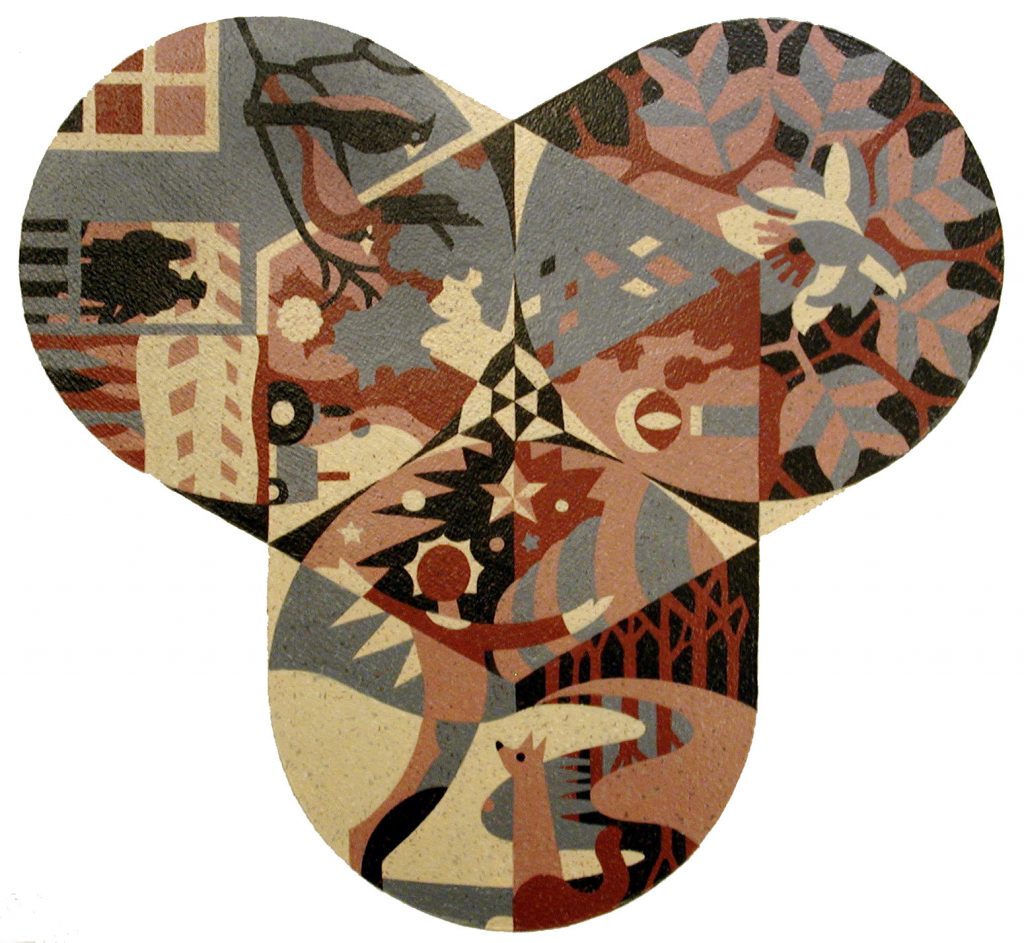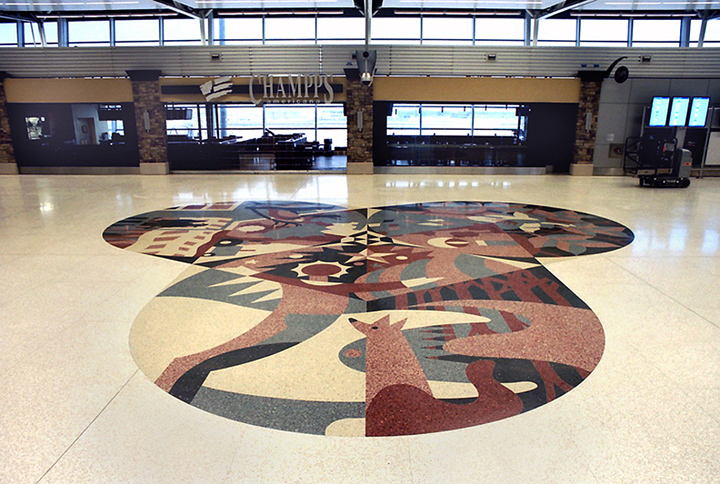Work of Heart, 2008

for Indianapolis International Airport
Work Of Heart, 2007
acrylic on paper
12 x 12″

Indianapolis International Airport
terrazzo
36 x 36′
The inspiration and imagery for my proposed Terrazzo tile floor piece (which will have a red color scheme, as opposed to the blue of my sports design) come from two sources. The first source is a book written and illustrated by Antoine de Saint Exupery (1900-1944) entitled The Little Prince. The author/artist was an aviator who, through his flying experiences, was better able to understand the mysteries of life. The second source is a song written by Paul Dresser (1859-1906) in 1913 entitled On the Banks of the Wabash, Far Away. This song, beloved to so many Indiana residents, is rich with images that found their way into my design.
I include the lyrics to Dresser’s song below in part; perhaps the images of the song could be kept in mind as you review my overall design and its component parts.
On the Banks of the Wabash, Far Away
‘Round my Indiana homestead wave the cornfields,
In the distance loom the woodlands clear and cool,
Oftentimes my tho’ts revert to scenes of childhood,
Where I first received my lessons – nature’s school.
CHORUS
Oh, the moonlight’s fair tonight along the Wabash,
From the fields there comes the breath of new-mown hay,
Through the sycamores the candle lights are gleaming,
On the banks of the Wabash, far away.
Because the Little Prince made such an impression on me and because the book is not known well to everyone, let me discuss the book in some depth. The little prince lived alone on a tiny planet the size of a house. On this planet were three volcanoes. Tow active and one extinct. Also on the planet was a flower, unlike any flower in all of the galaxy. This flower was so beautiful and filled with pride. It was this pride that ruined the serenity of the Little Prince’s world and started him on interplanetary travels that brought him to earth. Where he finally learned from a fox the secret of what is important in life.
Life, Love, and the Little Prince
The star represents a longing for love. The red fox represents the creature that taught the Little Prince the ways of life and love. This fox, along with much of the other imagery in my design, refers to the line in the song, “Oftentimes my thoughts revert to scenes of childhood, Where I first received my lessons – nature’s school.” The trees and river refer to the banks of the Wabash.
The Moonlight is Fair Tonight
In this image, two people on an Indiana homestead look over the fields of corn and wheat. From Dresser’s song, “Without her face it seems so incomplete, I long to see my mother in the doorway, As she stood there years ago, her boy to greet.” The wavy lines below the tractor refer to the lines in the song, “Oh, the moonlight’s fair tonight along the Wabash, From the fields there comes the breath of new-mown hay.” Also pictured in this section are two cardinals, the Indiana state bird, in a Sycamore tree.
The Fire Within Us All
This portion of the design depicts a candle (mentioned in the song) and represents the fire of life within us. The flower, a pleasant image for any season, is an allusion to the rose that the Little Prince cares for with so much dedication. The leaves are those of the Yellow Poplar or Tulip Tree, the state tree of Indiana. The natural images of a flower and leaves serve to remind viewers of the striking and inspiring features in nature that can be found in our state.
The structure of the overall design is comprised of three interlocking hearts, which represent love. At the point in the center of the design where the hearts overlap is an image of a gem if you will. The gem has a twofold meaning. One, it represents how Hoosiers feel about their state and two, it symbolizes Indianapolis’s central location in Indiana. The gem, in addition, mirrors the faceted style of the piece and reinforces the design’s overall celebratory character.
I believe my design, although personal in terms of its initial sources of inspiration, would appeal to the sentiments of those who are proud to call Indiana their home. More importantly, however, the design greets visitors to Indiana with pleasing images of the natural world and symbols of an uplifting character. These visitors can see right at their point of arrival that here is a place where a heartening spirit of sentimentality and a desire to maintain continuity with the past are alive and linked to the identities of the residents. From an agrarian past to a modern future, Indiana stands at the crossroads of America; the interlocking design pieces revolving around the gem in the center overall seem to say that Indiana is firmly in the heart of the country and benefits from the collaboration and support of its neighbors near and far.
 tomtorluemke.com
tomtorluemke.com